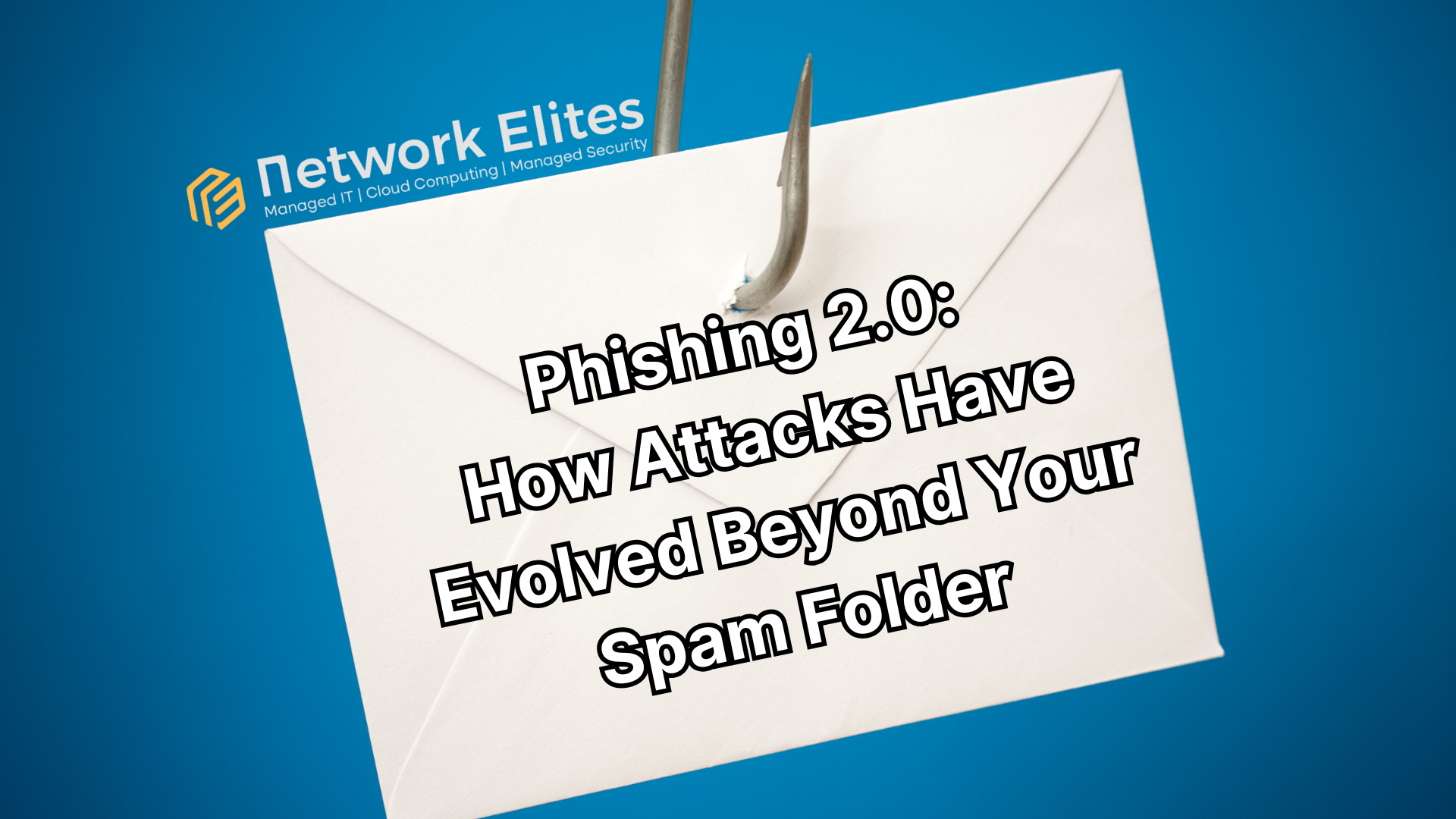Phishing 2.0: How Attacks Have Evolved Beyond Your Spam Folder
Remember when phishing meant obvious emails from Nigerian princes asking for your bank details? Those days are long gone. Modern phishing attacks have evolved into sophisticated, targeted operations that bypass traditional security measures with alarming success.
Phishing started as crude mass-email campaigns that flooded inboxes with poorly written messages. Most users could spot these scams from a mile away. But cybercriminals have learned from their mistakes. They now craft personalized attacks that look legitimate, target specific individuals, and exploit channels far beyond email.
The statistics paint a concerning picture. According to recent cybersecurity reports, 91% of successful data breaches begin with a phishing attack. Even more troubling, these attacks now succeed 30% more often than they did just five years ago. The reason? Attackers have moved beyond your spam folder to exploit human psychology and trust across multiple platforms.
Understanding how phishing has evolved is crucial for protecting yourself and your organization. Let's explore the sophisticated techniques cybercriminals use today and how you can defend against them.
The Evolution of Phishing Techniques
Spear Phishing: Precision Over Volume
Gone are the days when attackers sent identical emails to millions of people. Spear phishing represents a targeted approach where criminals research their victims extensively before striking.
These attacks use personal information gathered from social media, company websites, and data breaches. An attacker might pose as your colleague, reference a recent project you worked on, or mention a mutual connection. The email looks authentic because it contains real details about your life or work.
The FBI reports that spear phishing attempts have increased by 65% over the past three years. These attacks succeed because they exploit familiarity and trust rather than relying on generic lures.
Whaling: Going After the Big Fish
Whaling takes spear phishing to the executive level. These attacks target CEOs, CFOs, and other high-profile executives who have access to sensitive information or financial controls.
Whaling attacks often impersonate board members, legal counsel, or regulatory authorities. They might request urgent wire transfers, sensitive documents, or login credentials. The pressure to respond quickly, combined with the apparent authority of the sender, makes these attacks particularly effective.
One recent case involved attackers impersonating a CEO and requesting an emergency wire transfer worth $500,000. The finance team complied within hours, believing the request was legitimate.
Smishing and Vishing: Beyond Email
Attackers now use SMS messages (smishing) and voice calls (vishing) to reach victims. These channels often feel more immediate and trustworthy than email.
Smishing attacks might warn you about suspicious account activity or offer limited-time deals. The messages include links to fake websites that steal your credentials or install malware on your device.
Vishing involves phone calls where attackers impersonate bank representatives, tech support agents, or government officials. They create urgency by claiming your account has been compromised or you face legal action unless you provide sensitive information immediately.
These attacks work because people associate phone calls and text messages with legitimate communication from trusted sources.
Social Media Phishing: Exploiting Trust Networks
Social platforms have become fertile ground for phishing attacks. Criminals create fake profiles that appear connected to your network, then send malicious links through direct messages or comments.
LinkedIn phishing has become particularly common. Attackers pose as recruiters, business partners, or industry contacts. They send connection requests followed by messages containing malicious attachments or links to credential-harvesting websites.
Facebook and Instagram attacks often involve fake contests, urgent security warnings, or messages from compromised accounts belonging to people you actually know.
Why Traditional Methods Aren't Enough
Spam filters and email security gateways focus primarily on email-based threats. While these tools remain important, they cannot address the multi-channel nature of modern phishing attacks.
Traditional security measures also struggle with context. A spam filter might block an obvious phishing email, but it cannot detect when someone receives a LinkedIn message from a fake recruiter followed by a convincing phone call.
Human psychology presents another challenge. Even security-aware individuals can fall victim to well-crafted attacks that exploit stress, curiosity, or the desire to help colleagues.
The shift toward remote work has amplified these vulnerabilities. Employees working from home may have less IT support and fewer colleagues nearby to verify suspicious requests.
How to Protect Yourself and Your Organization
Employee Training
Security awareness training must evolve beyond annual presentations about email safety. Effective programs teach employees to recognize threats across all communication channels.
Training should include real-world scenarios that employees might encounter. Practice exercises using simulated phishing attempts help people apply what they learn in low-risk situations.
Regular updates keep training relevant as new threats emerge. Monthly security tips or quarterly workshops ensure that security awareness remains top-of-mind.
Advanced Security Solutions
Multi-layered security approaches provide better protection than any single tool. Email security gateways should work alongside endpoint protection, network monitoring, and user behavior analytics.
Advanced solutions use artificial intelligence to detect suspicious patterns that traditional filters might miss. These systems can identify when multiple communication channels target the same individual or when unusual requests coincide with external threats.
Zero-trust security models assume that every request could be malicious, regardless of its apparent source. This approach requires additional verification for sensitive actions, even when requests appear legitimate.
Multi-Factor Authentication
Multi-factor authentication (MFA) provides crucial protection when phishing attacks succeed in stealing credentials. Even if attackers obtain usernames and passwords, they cannot access accounts without additional verification factors.
Modern MFA solutions go beyond SMS codes, which attackers can intercept. App-based authentication, hardware tokens, and biometric verification provide stronger protection.
Organizations should implement MFA for all critical systems, not just email and financial applications. This includes cloud services, remote access tools, and administrative accounts.
Regular Security Audits
Periodic security assessments identify vulnerabilities before attackers exploit them. These audits should examine technical controls and human factors that contribute to successful phishing attacks.
Penetration testing includes social engineering assessments that simulate real-world phishing scenarios. These exercises reveal gaps in training and technical defenses.
Regular reviews of security policies ensure that procedures remain effective as threats evolve. Incident response plans should address multi-channel attacks that might not trigger traditional security alerts.
Staying Ahead of Evolving Threats
Phishing attacks will continue evolving as criminals develop new techniques and exploit emerging technologies. The key to protection lies in understanding that cybersecurity requires ongoing vigilance, not one-time solutions.
Organizations must adopt comprehensive approaches that address technical vulnerabilities and human factors. This means investing in advanced security tools while maintaining regular training programs that keep pace with evolving threats.
Individual users play a crucial role in organizational security. By staying informed about current threats and maintaining healthy skepticism about unsolicited communications, employees become the first line of defense against sophisticated attacks.
The landscape of cyber threats changes rapidly, but the fundamental principles of protection remain constant: verify before trusting, maintain multiple layers of defense, and stay educated about emerging risks.
Don't wait for the next attack to test your defenses. Network Elites can help assess your current security posture and implement comprehensive protection strategies tailored to your organization's specific needs. Contact us today to schedule a security consultation and take the first step toward stronger cyber resilience.








